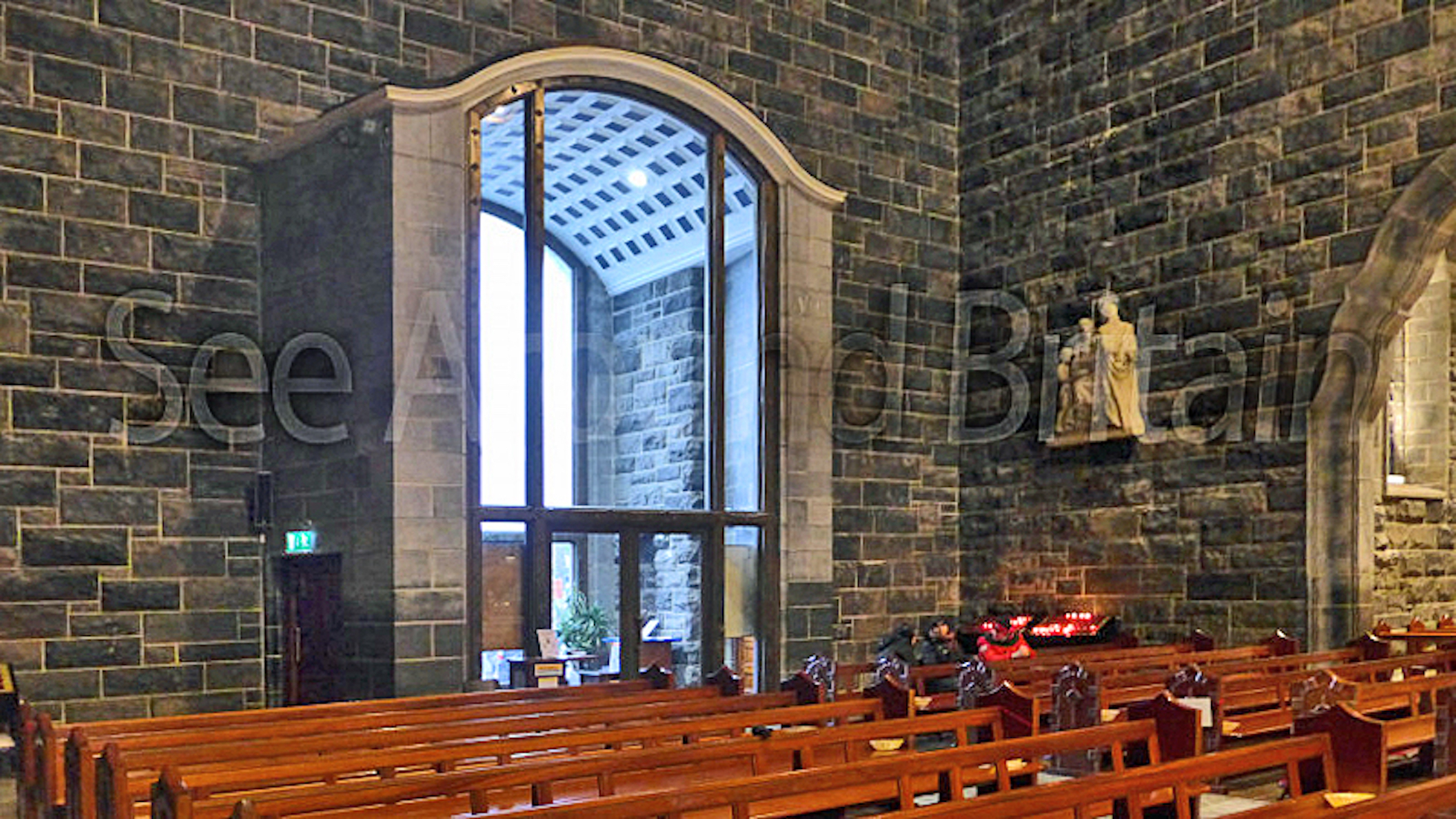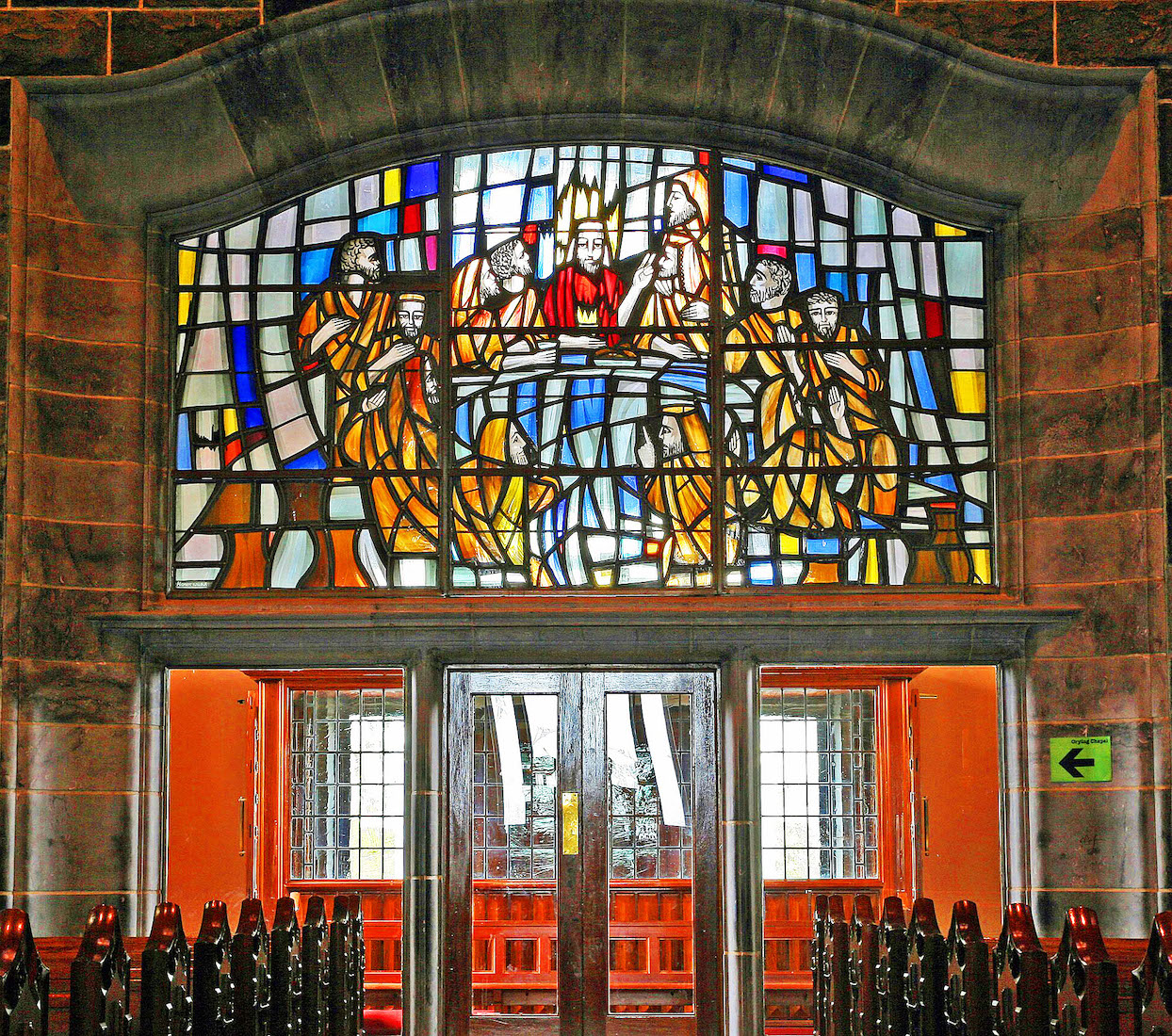
If we visited at Easter time we might well see this impressive display of the rock tomb with the stone rolled away. The Risen Christ stands above, and there are other figures relating to the time: a crucified figure at right, an angel, a fallen Roman Centurion, and the two women who came to the tomb early in the morning. INDEX
42. CATHEDRA PRS PRS


On the North side of the platform we find the cathedra, or Bishop’s throne. We expect to find this in a cathedral: it symbolises the fact that of all the churches in this diocese, this is the Bishop’s ‘special’ church. The word ‘cathedra’ means ‘seat’ in Latin, and it is from this word that the title ‘cathedral’ is obtained.
43. HOLY WATER LM
In this Cathedral we may well find the holy water in an unusual container! Like the crucifix we found earlier in the West nave, the holy water may move from location to location within the Cathedral. Holy water is water that has been blessed by a member of the clergy or a religious figure. Sometimes it is water derived from a well or spring considered holy.
44. NORTH TRANSEPT CONFESSIONALS LM
We take time to look at the North transept. Along the West wall are two confessionals – enclosed stalls divided by a screen or curtain in which a priest sits to hear confessions. The word ‘confessional’ is falling out of favour in many churches and cathedrals, being replaced by ‘reconciliation room’. •• Two of the Stations of the Cross can be seen above the confessional doors.
45. TRANSEPT WEST WINDOWS LM MML
Above the confessionals on this wall are two high clerestory windows, depicting Melchisedek and Isaac. Melchisedek was King of Salem, but is remembered for his great age – 365 years according to Jewish legend. The Isaac window shows Isaac about to be killed and given as a sacrifice to God by Abraham.
46. ROSE WINDOW PRS
The rose window of the North transept is made up of a circular centre with five small petals surrounded by five larger petals. The five large outer petals depict the Sorrowful Mysteries of the Rosary. In order, going clockwise from the upper-right to the very top, they are: ‘The Agony of Jesus in the Garden’, ‘The Scourging at the Pillar’, ‘Jesus is Crowned with Thorns’, ‘Jesus Carries the Cross’, and ‘The Crucifixion of our Lord’.
47. ACROSS THE TRANSEPT SAB
We now look across the transept past the tall entry glass to the East side. This inside glass is clear; as we have seen earlier, the outside glass is etched. On the far wall is the first of the Stations of the Cross, and an arched entry through to the Chapel of St Nicholas.
48. HIGH EASTERN WINDOWS MML MML
There are two further high clerestory windows on the East wall of the transept. We find Jacob and Joseph depicted here.
49. ACROSS TO THE SOUTH TRANSEPT WM
We next make our way across the Cathedral to the South transept, seen here on the other side of the crossing. Stations #12 and #13 of the Cross are visible on the right wall of the transept, and the final Station on the left. On the far wall we see another rose window with an interesting stained glass panel below.
50. HIGH EAST WNDOWS OF THE SOUTH TRANSEPT PRS PRS
Looking at the South transept windows, there are two high windows on the Eastern side, depicting two unidentifiable incidents from the Old Testament!
51. SOUTH ROSE WINDOW LM
The rose window of the South transept is designed so that the five large outer petals of the window depict the Glorious Mysteries of the Rosary. In order, going clockwise from the upper-right petal to the top-most petal, they are: ‘The Resurrection of Jesus Christ’, ‘The Ascension of Jesus to Heaven’, ‘The Descent of the Holy Ghost’, ‘The Assumption of Mary into Heaven’, and ‘Mary is Crowned as Queen of Heaven and Earth’.
52. LAST SUPPER W-U
The doors to the South of the South transept lead through to a small Mothers’ Chapel (or Children’s Room) and to an exterior exit door. The stained glass window shown here is of Jesus and the disciples at the Last Supper. [Photo Credit: Unukorno]
53. CONFESSIONALS AND STATIONS LM
The Stations of the Cross on the West wall of the transept show Jesus on the cross, and then his body being taken down.
54. HIGH WEST WINDOWS PRS PRS
Two well known scenes are shown in the clerestory windows high on this wall. Al left King David plays his harp (lyre), and at right Solomon makes his famous judgement on the disputed motherhood of a baby. He threatens to chop the baby in half, only to be deterred by the true mother (I Kings 3:16 – 28).
55. AISLE TO RETROCHOIR RL
From the South transept, an aisle leads East through to the retrochoir. [Photo Credit: Robert Lindsell]
56. TO CHAPEL OF ST COLMAN PRS
The Chapel of St Colman is found on the right. Saint Colman or Kolonat (c. 600 – 689 AD) was an Irish-born Christian priest, and missionary to Germany where he died. On a Cathedral sign, this Chapel is also called ‘Our Lady’s Chapel’.
57. COLMAN CHAPEL WINDOWS MML (x5)
There is a nice set of five windows in the Chapel of St Colman, although the window at left has a different style, and looks to be a ring-in! The windows show, from left: Jesus with a shepherd’s crook; •• Jesus washing a disciple’s feet; •• Jesus being baptised by John; •• Jesus stilling the storm; •• and Mary Magdalene anointing the feet of Jesus. The set of four windows were designed by Patrick Pollen.
58. ALTAR OF CHAPEL OF ST COLMAN SAB MML
The wall at the East end of this chapel is painted with a dramatic scene, presumably from the life of St Colman. Standing in front is a golden statue of Our Lady.
59. ACROSS TO THE ST NICHOLAS CHAPEL WM
Directly across the retrochoir from the St Colman Chapel is the St Nicholas Chapel. However, as we cross the retrochoir, we become aware of a scale model of the Cathedral standing between two of the Southern columns of the retrochoir.
60. CATHEDRAL MODEL LM
Many cathedrals contain a model of the building, and it is useful to spend time with the model to gain an overall impression.




























